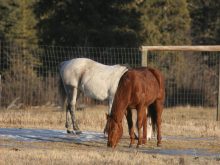Earlier this spring we had some desperately needed rain in parts of Western Canada.
We still need more moisture in many areas but the rain in some locations will at least give the grass a good start in the pastures.
However, after a recent phone conversation with another veterinarian I was reminded of a condition that we can see in cattle and sheep as a direct result of that lush grass growth. That condition is caused by low magnesium in the blood and is often known as grass tetany, grass staggers or hypomagnesemic tetany.
Read Also

Pork sector targets sustainability
Manitoba Pork has a new guiding document, entitled Building a Sustainable Future, outlining its sustainability goals for the years to come.
Magnesium is one of the seven essential macrominerals. Ruminants store it in their bones and muscles. However, cattle need a constant source of magnesium in their diet because they can’t readily mobilize magnesium from their bones as they do with calcium. One of the biggest drains of magnesium from their system is milk production. Milk has a high magnesium concentration and, as a result, cows at peak lactation are at high risk of this disease.
The setting for this condition usually includes turning lactating cows or sheep onto lush, new, cool-season grass pasture in the spring. Magnesium levels are much lower in the early growth of cool season grasses and cereals as compared to legume pastures.
Magnesium also tends to be much lower in grasses grown on sandy soils or when pastures are fertilized heavily and growth is rapid.
Finally, the high moisture content of those rapidly growing grasses causes much more rapid transit in the gut of the animal and reduces the uptake of magnesium.
Other stresses such as transportation, bad weather and sudden changes of feed may affect intakes and can exacerbate low magnesium levels. Grass tetany has a very complicated relationship with several other macrominerals such as potassium and calcium. Excessive calcium and potassium levels in the diet can interfere with magnesium uptake as well.
Early signs will be cows that appear excitable and have some muscle twitching.
They are often hypersensitive to sound, urinate frequently and may be aggressive. The affected cows may have a stiff gait or may suddenly gallop off in a frenzy.
Within a short time, the animals will fall and begin to have severe paddling convulsions. Their legs will often be stiff and outstretched, they may breathe heavily and foam at the mouth, and the animal’s eyelids may be blinking rapidly or snapping.
The heart rate is often high as the muscles of the heart are affected in the same fashion as the skeletal muscles, and in the cases I’ve examined, the heart is unusually loud and rapid when I listen with my stethoscope.
The clinical signs of this disease come on rapidly and, in many situations, the cow can die within hours of clinical signs presenting.
If cows are turned out on pasture in the afternoon or evening, the animals may be found dead the next morning.
Unfortunately, it is difficult to diagnose at postmortem because there will be no significant changes in the visible tissues.
There may be evidence of leg paddling on the ground around the dead animals.
This is a true emergency because treatment needs to be initiated as soon as possible.
Multiple animals are often affected at one time and triage may be necessary to treat the worst cases first.
Early cases can be treated successfully but the treatment success drops once the animals start convulsing.
Veterinarians will usually administer a slow intravenous injection of a combination of calcium, phosphorus and magnesium while monitoring the heart rate. Vets might also administer some of this treatment under the skin of the animal.
It is common that calcium levels in the blood of affected animals are low in combination with the low magnesium.
You need to work quickly and quietly around these animals because too much stimulation can cause them to go into convulsions.
It’s important to note that animals with hypomagnesemia tend to not respond as quickly to treatment as do cows with low calcium or milk fever. It is also common to see relapses in cows that are treated for this condition.
In my experience, some cows will be aggressive after being treated and the producer and veterinarian should be aware that these cows will charge if they can stand. The affected group should be moved off the magnesium-deficient pasture and supplemented with hay and some sort of magnesium.
The main way to prevent this condition is to ensure adequate dietary magnesium intake. Using legumes in pastures will greatly decrease the risk.
If you have high-risk pastures, you might want to wait to turn out cows until the forage reaches a height of 10 to 15 centimetres because magnesium levels will be higher in the more mature grass. Most of our trace mineral supplements don’t contain macrominerals such as magnesium.
Supplementation of magnesium in the diet in the form of magnesium oxide may be necessary, but it’s important to recognize that magnesium oxide is not very palatable to cows. They are reluctant to consume it when it is just mixed with a forage. It may have to be mixed with equal parts of a trace mineral salt, along with some grain to get cows to eat adequate amounts.
John Campbell is a professor in the department of Large Animal Clinical Sciences at the University of Saskatchewan’s Western College of Veterinary Medicine.

















